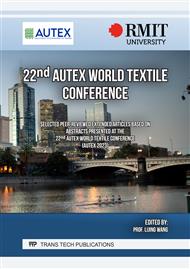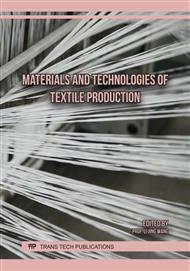p.17
p.23
p.29
p.37
p.47
p.55
p.63
p.73
p.81
Development of a Process to Continuously Mercerise Loose-Stock Cotton
Abstract:
Cotton has traditionally been mercerised as hanks of yarn or as open-width fabrics, but commercial methods to mercerise loose stock directly after ginning have been limited. Arnold and Rippon [1,2] produced continuous lengths of fully mercerised sliver with increased fibre strength, enhanced dye-uptake, improved surface lustre, without fibre shrinkage. Not only did the method prevent shrinkage, but fibres could be stretched by as much as 4% and then stably set. The disadvantage of this method was that fibre had to be fully processed to sliver form.An improved prototype machine has now been successfully developed to continuously mercerise ginned loose stock. Testing has confirmed that the output fibres are mercerised along their full lengths and have higher tenacity compared with the un-mercerised Control. Fibre lengths have also been maintained, indicating that the shrinkage normally caused by slack mercerising has been prevented. Fibre dyeability is comparable with that of slack-mercerised samples but better than the un-mercerised Control. The improved lustre expected for fibre mercerised under tension has also been confirmed. The production rate of the process can be readily improved, and the prototype expanded in size to increase output.
Info:
Periodical:
Pages:
73-80
Citation:
Online since:
March 2024
Authors:
Keywords:
Price:
Сopyright:
© 2024 Trans Tech Publications Ltd. All Rights Reserved
Share:
Citation:



